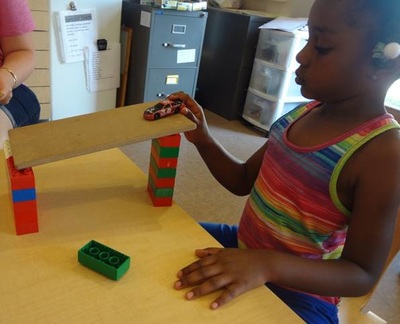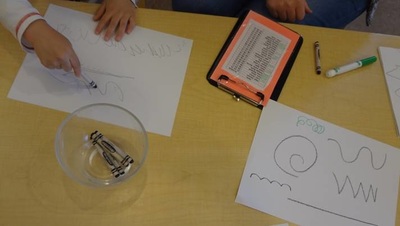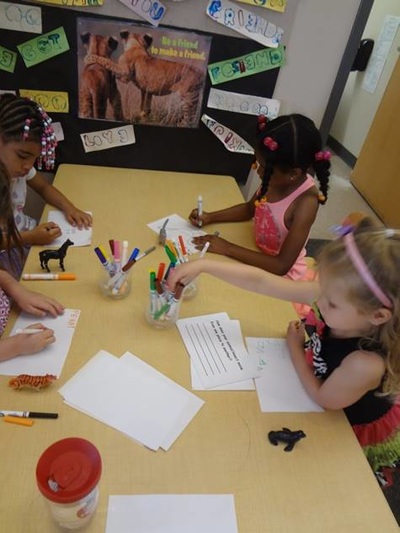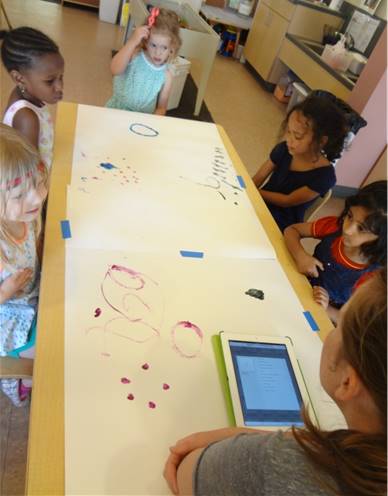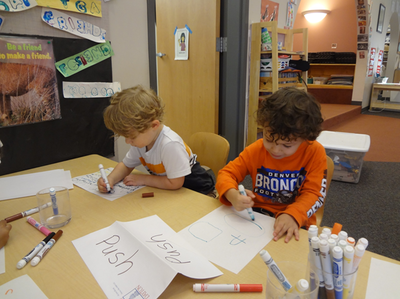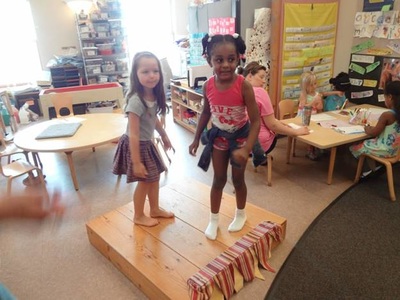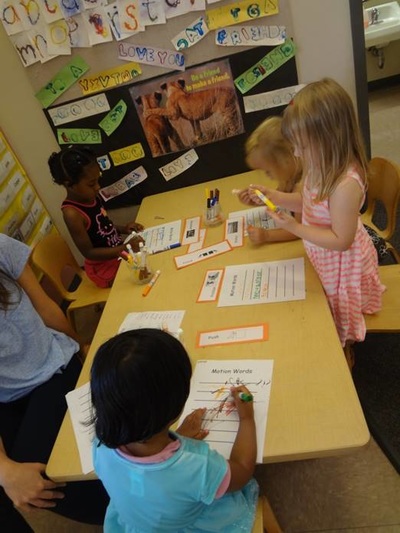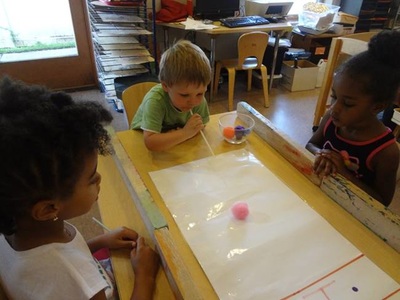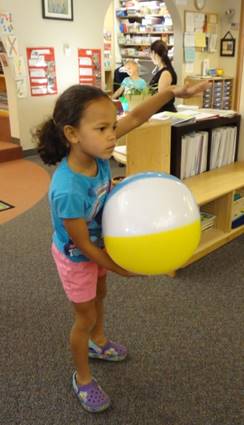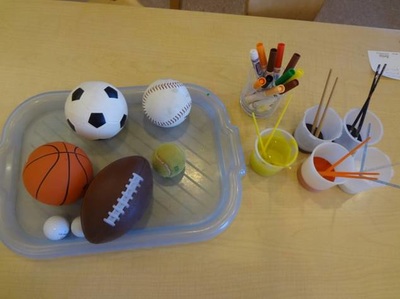MovementPreschool InvestigationMotion is one of the most important topics in physical science because everything in the universe moves. It impacts many things that we do. Motion is the changing of position or location. In order to change a force is applied. During this investigation we will be looking at how our bodies can push or pull objects. The Voyagers are interested in moving their bodies to music or playing large motor games (baseball, soccer, etc.).
During our transition to our summer schedule we noticed that the children could focus better if they had outdoor time first. When children are playing outside they have to engage all parts of the brain to make decisions about what they are going to play and how they are going to move their bodies. Outside play really warmed up their brains and then they were ready to focus on indoor experiences. |
As we were planning for summer, we thought the children would like to investigate the topic of movement further. The children will be looking at their bodies as a simple machine as we push and pull objects and participate in music and movement exercises. We would like to look at how we push and pull to play games with rules such as baseball, soccer, basketball, etc. CONCEPT PLANNER
| ||||
DOCUMENTATION OF PROCESSBefore the class delved into their Movement Investigation, the children spent some time brainstorming what movement is. The children shared ways to move, different directions people and objects move, and various things that move in different ways.
The children experimented with moving their bodies in various ways to music. They changed position and motion of their bodies. During this experience, the children discovered that they can move their bodies in many different ways. They also practiced coordination and strengthened muscles to perform non-locomotive (moving while stationary) and locomotive (moving while also moving your body with your feet form one place to another) skills. |
Beginning the InvestigationConnecting Movement to Familiar Objects and ExperiencesCars and Roads
To begin the Movement Investigation, children experimented with position and motion of cars by constructing roads in different ways. The children discussed directional words like circle, X, zigzag, curve, etc. while building roads and pushing cars across the roads. They investigated ways they could make marks on paper by changing the direction in which they were moving their crayon on their paper. In another learning experience, they continued to explore directionality by putting cars in paint before driving them on their paper. They made different types of lines on their paper including zigzag, curves, straight, etc. During this experience the children were able to demonstrate the ability to put objects in motion and manipulate objects in motion. They were also able to refine their ability to make precise movements with tools.
Wheels from Home
The we began to dive deeper into movement by manipulating objects with wheels. To connect to families and reach younger children, we asked children to bring an object from home that has wheels. They experimented with pushing and pulling the object with a partner. The children discovered that it was easier to pass the object by pushing rather then pulling. They were able to develop and understanding of the concept of push and pull through this experience. During another experience the children drew a card with a number and attempted to push their object to the number on the chart. The children experienced pushing and pulling while also refining their ability to identify numbers. They also created ramps for their vehicles to see if they could make their objects move without being pushed. During this experience they found that gravity and the angle from the ramp caused the object to move without being pushed or pulled by their hands. They also noticed that the rolling down the ramp also caused the the objects to roll faster than when pushed or pulled on a flat surface. |
How can objects move?Starting with Rolling and RotationExperimenting with Ramps
After experimenting with ramps with our toys from home the Voyagers explored ramps further. They used a ramp that was premade to measure how far objects would go without adding a force. Then they used blocks to create their own ramps for experimentation. Blocks were added to make the cars go faster/further and taken away to make the cars go slower/shorter distance. During this experience the children used the engineering process to develop ramps and changed the ramps to find a solution to their problem. They were able to demonstrate how to demonstrate an ability to manipulate position and motion of objects. Using Legos and wood blocks the children built ramps to experiment with. By building with different numbers of Legos the children created differing degrees of inclines. They then used the cars to test which inclines let the car go faster or slower. The children were asked to predict which incline would be faster or slower and then asked to explain why.
Ramp Races
Using trays and a variety of classroom objects the children would had ramp races to see which items would move faster when the tray was tilted. The children observed and talked about which objects moved the fastest and which ones moved more slowly. The children were then asked to come up with a theory of why some items were faster than the others. They talked about the textures of the items and how some had more friction than others which could cause the item to move more slowly. Marbles
While investigating movement, the children explored moving marbles with two types of marble mazes. The children were encouraged to build a structure that would move the marble from here to there. They discovered that they could push the marble to move it or create a structure that slanted down to move the marble. During this experience they also found that the marble would move in different ways depending on the piece that was chosen (back and forth, straight, etc.). Spin Art
During this experience the children explored objects in spinning motion. They first traced and cut out a circle that would fit in a salad spinner. Then they put the circle in the salad spinner and dropped liquid water colors on it. Next they put force on the salad spinner to make it spin the paint around on their paper. Lastly they looked at their work to be sure they did not want to make any changes. During this experience the children were able to demonstrate the ability to manipulate the position and motion of paint on their paper using a salad spinner. |
How can objects move?
Crayons
The children experimented with moving a black crayon in different ways on paper. They were able to create straight, curves, zigzag, circles, etc. lines on paper. During this experience they were able to discover how to change position of an object. After they drew their lines they painted their creation with water color paints. They used creative and flexible thinking to solve how to move a crayon in different ways to create different marks.
The children experimented with moving a black crayon in different ways on paper. They were able to create straight, curves, zigzag, circles, etc. lines on paper. During this experience they were able to discover how to change position of an object. After they drew their lines they painted their creation with water color paints. They used creative and flexible thinking to solve how to move a crayon in different ways to create different marks.
|
HOW DO ANIMALS MOVE?
During a movement experience the children explore various animals and how they move from here to there. They began by sorting animals by the way they move (walk, swim, fly). While sorting they described how the animal moves. Then they focused on one animal of their choice. They used a plastic animal model to draw a representational drawing of the animal. Then they described how their animal moves from here to there. |
|
WRITING MOVEMENT WORDS
The children explored new vocabulary words writing the letters of the words in clusters. They also drew a picture that represented the meaning of the word. During this experience the children demonstrated an understanding of new words and ability to form letters and connect sounds to letters. |
|
PAINTING TO MUSIC
The voyagers practiced manipulating the position of their paint brushes to make individual and group work. We added music to enhance the experience to encourage children to paint to tune, rhythm, tempo of the music to make different marks on their paper. They also discussed how the music made them feel and how they could move the brush to represent how they felt. |
|
MOVING OUR BODIES
During our study of movement, we explored ways that we could move our own bodies. The children rolled two dice one with numbers and one with movements. Then the side that was up told them which movement and how many times. During this experience the children discovered new ways to move their bodies, demonstrate non locomotor and locomoter skills with control and coordination, and practiced identifying numbers. They also demonstrated socially competent behavior by showing the ability to take turns with peers. CREATED NEW MOVEMENTS FOR DICE
After viewing books and exploring new ways to move their bodies the children discovered new ways to move their bodies. Then we took a picture of the movement to add to our dice game. The children demonstrated the ability to use large muscles to perform locomotor and non-locomotor tasks. During this experience the children worked on developing stronger muscles that allow them to perform gross motor tasks. |
PUSH & PULL OBJECTS
The Voyagers further investigated the concepts of push and pull with various objects in the room. They used the objects to answer the following set of questions.
Questions:
Will the object move by itself?
Which items are easy to push and which are easier to pull?
What happens if you put more force on the object?
Are some items harder to push or pull?
Which items go further?
The Voyagers further investigated the concepts of push and pull with various objects in the room. They used the objects to answer the following set of questions.
Questions:
Will the object move by itself?
Which items are easy to push and which are easier to pull?
What happens if you put more force on the object?
Are some items harder to push or pull?
Which items go further?
COMPARING PUSH & PULL WITH SORTING
The children participated in several sorting activities dealing with push and pull. In the first they looked through magazines to find pictures of objects that were either pushed or pulled. They then cut the pictures out and glued them on paper according to whether they were pushed or pulled. In another activity, using hula hoops to create a Venn diagram the children placed various classroom objects as well as pictures on the diagram according to whether they could be pushed, pulled or both pushed and pulled.
The children participated in several sorting activities dealing with push and pull. In the first they looked through magazines to find pictures of objects that were either pushed or pulled. They then cut the pictures out and glued them on paper according to whether they were pushed or pulled. In another activity, using hula hoops to create a Venn diagram the children placed various classroom objects as well as pictures on the diagram according to whether they could be pushed, pulled or both pushed and pulled.
EXPLORING PULL
The children were asked write the word pull on their paper and then they were to draw a picture of themselves pulling something. They then described their work to the teacher who wrote down what they said.
To help the children understand the concept of pulling a basket was strung between two chairs. The children were asked how they could get the basket to move from one chair to the other without touching the basket. The children used their problem solving skills to figure out that they could move the basket by pulling on the string.
The children were asked write the word pull on their paper and then they were to draw a picture of themselves pulling something. They then described their work to the teacher who wrote down what they said.
To help the children understand the concept of pulling a basket was strung between two chairs. The children were asked how they could get the basket to move from one chair to the other without touching the basket. The children used their problem solving skills to figure out that they could move the basket by pulling on the string.
DISCOVERING PUSH & FRICTION
The children were asked to write the word push on their paper. They were then asked to draw a picture of something they could push and their words were recorded by the teacher.
To help the children understand the concept of friction the children shuffled their feet on three different surfaces. They were then asked which of the three surfaces was easiest to shuffle on, which was second easiest and which was the most difficult. They then discussed the concept of friction.
The children were asked to write the word push on their paper. They were then asked to draw a picture of something they could push and their words were recorded by the teacher.
To help the children understand the concept of friction the children shuffled their feet on three different surfaces. They were then asked which of the three surfaces was easiest to shuffle on, which was second easiest and which was the most difficult. They then discussed the concept of friction.
EXPERIMENTING WITH FRICTION & MOTION VOCABULARY
The children explored the concept of friction by rolling cars and balls over different surfaces. They tested paper, carpet, foil, foam, and wood to see which was easier to roll a car or ball across and which was harder to roll a ball or car across. At the writing table they practiced forming and recognizing letters by creating a list of motion words. During this experience they practiced naming letters, sounds, and blending sounds to read the words they were writing.
The children explored the concept of friction by rolling cars and balls over different surfaces. They tested paper, carpet, foil, foam, and wood to see which was easier to roll a car or ball across and which was harder to roll a ball or car across. At the writing table they practiced forming and recognizing letters by creating a list of motion words. During this experience they practiced naming letters, sounds, and blending sounds to read the words they were writing.
EXPLORING DIFFERENT WAYS TO PUSH & PULL
The children explored pushing and pulling familiar materials in the room. They used different type and sized balls to knock down small wooden blocks. During this experience the children found that the pins (blocks) needed a big push to fall down. Then they found that the heavier balls would give a bigger push and knock down more pins. They also discovered that they could pull the silly putty into strings and push it back together with their hands. At the writing table they practiced recognizing familiar motion vocabulary words. They used stamps to print and cluster the letters to make new vocabulary words.
The children explored pushing and pulling familiar materials in the room. They used different type and sized balls to knock down small wooden blocks. During this experience the children found that the pins (blocks) needed a big push to fall down. Then they found that the heavier balls would give a bigger push and knock down more pins. They also discovered that they could pull the silly putty into strings and push it back together with their hands. At the writing table they practiced recognizing familiar motion vocabulary words. They used stamps to print and cluster the letters to make new vocabulary words.
EXPLORING THE FORCE OF AIR & MASS WITH PUSH & PULL
Using containers filled with a variety of objects the children would push and pull the containers. They discussed which containers were easier to push and pull and which ones were harder. The children then hypothesized why they were easier or harder to push or pull.
Using differing sizes of pom poms and a straw the children took turns blowing the pom poms on a chart. They were asked to predict which pom pom would go the furthest and why. After they were done they discussed their results and their predictions.
Predictions: "The pom poms are easiest and the rocks are the hardest".
Results: "Pom poms are the easiest and the rocks the hardest because I can’t really move they are heavy". –Eloise
"Rice is easier. Rocks are strong. Pom poms are easier to move". –Seamus
"Rocks are hardest because they are heavier. Then the pom poms. The rice is the easiest because it is not heavy". –Jaylin
"Rocks are harder. Rice is easier. Pom poms are easier". –Danny
"Pompoms are easier. The rice was harder. Stones will be harder because they are heavier". –Kaya
"Rice is harder to push than the pompoms. Stones are harder to push and pull". –Evan
"The hardest is the rocks than the rice. The pom poms are the easiest because the rocks are heavier". –Jade
"Rocks is the hardest, rice, then the pom poms are the easiest because they fall out quick. Rocks are harder that’s why they are hard to push and pull". –Maya
"Pom poms are hard. Rice is easy because it’s easy to push. Rocks are harder because they are too heavy for my arms". –Nahla
Rocks are hard. Rice is easy. Pom poms hard. –Daksha
Pom poms easiest. Rice is easy. Rocks are heavy because they are heavy. –Kennedy
Rocks: This is hard. Pom poms: easiest . Rice: This is even softer. –Luisa
Using containers filled with a variety of objects the children would push and pull the containers. They discussed which containers were easier to push and pull and which ones were harder. The children then hypothesized why they were easier or harder to push or pull.
Using differing sizes of pom poms and a straw the children took turns blowing the pom poms on a chart. They were asked to predict which pom pom would go the furthest and why. After they were done they discussed their results and their predictions.
Predictions: "The pom poms are easiest and the rocks are the hardest".
Results: "Pom poms are the easiest and the rocks the hardest because I can’t really move they are heavy". –Eloise
"Rice is easier. Rocks are strong. Pom poms are easier to move". –Seamus
"Rocks are hardest because they are heavier. Then the pom poms. The rice is the easiest because it is not heavy". –Jaylin
"Rocks are harder. Rice is easier. Pom poms are easier". –Danny
"Pompoms are easier. The rice was harder. Stones will be harder because they are heavier". –Kaya
"Rice is harder to push than the pompoms. Stones are harder to push and pull". –Evan
"The hardest is the rocks than the rice. The pom poms are the easiest because the rocks are heavier". –Jade
"Rocks is the hardest, rice, then the pom poms are the easiest because they fall out quick. Rocks are harder that’s why they are hard to push and pull". –Maya
"Pom poms are hard. Rice is easy because it’s easy to push. Rocks are harder because they are too heavy for my arms". –Nahla
Rocks are hard. Rice is easy. Pom poms hard. –Daksha
Pom poms easiest. Rice is easy. Rocks are heavy because they are heavy. –Kennedy
Rocks: This is hard. Pom poms: easiest . Rice: This is even softer. –Luisa
EXPLORING THE FORCE OF AIR & WEIGHT
Using straws the children blew pom poms through an obstacle course that they built using blocks. The children used the force of the air to manipulate the position and movement of the pom poms.
Rubber bands were wrapped around an empty plastic cup. The children took turns adding small stones to the cup which was held by a teacher. While the stones were being added the children observed the changes in the length of the rubber bands and then measured how far the rubber bands had stretched.
Using straws the children blew pom poms through an obstacle course that they built using blocks. The children used the force of the air to manipulate the position and movement of the pom poms.
Rubber bands were wrapped around an empty plastic cup. The children took turns adding small stones to the cup which was held by a teacher. While the stones were being added the children observed the changes in the length of the rubber bands and then measured how far the rubber bands had stretched.
EXPLORING THE FORCES OF PUSH & PULL
Using a hula hoop the children took turns pushing and pulling against each other. The children used their locomotive and cooperative skills to work together to move the hula hoop.
Using a variety of objects and a tray the children would push the objects. They observed which objects were easier to move and which objects moved further than others. The children then used non-standard units of measure to measure which objects went the furthest.
Using a hula hoop the children took turns pushing and pulling against each other. The children used their locomotive and cooperative skills to work together to move the hula hoop.
Using a variety of objects and a tray the children would push the objects. They observed which objects were easier to move and which objects moved further than others. The children then used non-standard units of measure to measure which objects went the furthest.
SOCCER
Using their loco motor skills and coordination the children took turns practicing soccer skills. The children were encouraged to pass the ball and move it around the grass area without using their hands.
Using their loco motor skills and coordination the children took turns practicing soccer skills. The children were encouraged to pass the ball and move it around the grass area without using their hands.
PAINTING WITH AIR & CHANGING POSITION OF A TRAY & BALL
Using complex oral/motor skills the children used straws to move the paint around on their paper to create a painting. The children were able to observe the blending of different colors to make new colors as they worked.
The children created another work of art by placing bouncy balls in different colors of paint which they then moved around the tray to make their painting.
Using complex oral/motor skills the children used straws to move the paint around on their paper to create a painting. The children were able to observe the blending of different colors to make new colors as they worked.
The children created another work of art by placing bouncy balls in different colors of paint which they then moved around the tray to make their painting.
BEACH BALL
GOLF
BALL STILL LIFE PAINTINGS
COMPARE & CONTRAST VARIOUS SPORTS
SALT DOUGH SPORTS BALLS
ASSESSMENT OF LEARNING
| MOVE IT MOVE IT PORTFOLIO PAGE | |
| File Size: | 47 kb |
| File Type: | |
RESOURCES & MATERIALS
|
RESOURCES:
Physics 4 Kids http://www.physics4kids.com/files/motion_intro.html PBS KIDS-Silly Putty Recipe http://www.pbs.org/parents/crafts-for-kids/homemade-silly-putty/ Learning for Kids-Salt Dough Recipe http://www.learning4kids.net/2012/12/09/how-to-make-salt-dough-recipe/ Scholastic Kids-Animal Moves http://teacher.scholastic.com/commclub/animal_moves_activity/index.htm You Tube videos on different sporting events
You Tube videos on how animals move
|
MATERIALS:
Various books on various sports Crayons & Paper Various tracks, blocks Cars Marbles Water Color Paint Different types of music (fast, slow) Paint Plastic Animals Ramps/Supplies to build Dice Camera Salad Spinner Legos/Wooden blocks Magazines Hula hoops String Baskets Foil Foam Wood Ball Cars |














